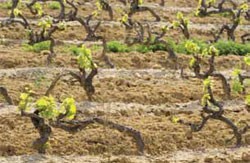The Place of the Grape

By Terri Sota
Terroir [tare-wah'] is a French concept that by definition means "soil," but is more commonly used to express a sense of "place." With respect to wine, terroir encompasses everything that imparts personality to the final product; it is the sum effect of the local environment and, some would argue, the imprint of the winemaker. More specifically, terroir is the intersection of climate (including sun exposure), soil type, topography (drainage, altitude, slope) and a slew of intangibles (indigenous yeasts, worm population, etc.).
Despite the literal translation of terroir, Australian researchers were unable to link any chemical component of soil with wine character — with the exception of nitrogen and potassium. High levels of nitrogen can create overgrown and unbalanced wines. Potassium facilitates sugar transport into the fruit; it flows into cells in exchange for hydrogen ions from organic acids, thus buffering the pH.
Experts agree that the physical properties of the soil do play a significant role in terroir. Soil's structure influences internal drainage, and its topography influences external drainage; both are predominant forces determining wine quality and character. Intensive soil and water management can often correct nature-made problems in the vineyard.
Pros and Cons
While a perfect soil for grape growing may not exist, an ideal climate is more quantifiable, with desirable measures of sunlight, rainfall, temperature and wind equating to fruit in abundance. These contributing factors have as much to do with the quality of the grape as the physical characteristics of the soil. The winemakers of France, for the most part, are ardent terroirists. According to Wine Spectator, "The flavors of wine made from a particular grape variety will change depending on the terroir where it grows, and the expression of the terroir will change depending on which grape variety is growing in it." Burgundy is often cited as the ultimate illustration of terroir. French agricultural regulators rank terroirs in the region as grand cru, premier cru and village.
The whole notion of terroir inspires passionate debate. Some winemakers dispute that it, alone, accounts for the individuality of a wine. They argue that the skills of the winemaker are as pervasive in every sip as the environment. Still others contend that true terroir does not take hold in a vineyard until the vines reach a certain age, or the roots grow to a certain depth. Some experts dismiss the presence of "place" entirely. The controversy will likely continue as long as the vino pours.
Classroom Discussion
- What are some of the geographical similarities shared by the wine- growing regions of California, Argentina and the Loire Valley?
- Why is terroir debate-worthy (Hint: Marketing)?
